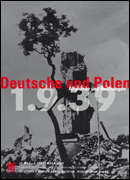


Exhibition | Oppression and Self-assertion | War and Occupation | Conflicts and Rapprochements
The Invasion
| Forced Labor
| Colonization, Deportation, Extermination
Genocide
| Resistance and Self-assertion
The End of the War
| Expulsion of the Germans
| Expulsion of the Poles
Through 1945, two to three million Polish civilians were taken to Germany to work as forced laborers in German farms, factories and offices and millions of people were forced to work for the German war machine inside Poland as well.
From the beginning, the recruitment practices of the German occupiers were characterized by terror and ruthless violence, as SS, police and army units organized raids and manhunts on Polish streets in an effort to meet Germany's growing need for manpower. Polish forced laborers living in Germany had to comply with strict rules and prohibitions. Their living conditions were far worse than those of Western European laborers given their "racially inferior" status.
Jews in occupied Poland were forced to work for the German occupiers. Many ghettos housed factories and workshops where Jews worked under inhuman conditions. The systematic exploitation of Jewish labor was the first stage of the Nazi plan to murder the Jews of Poland.
